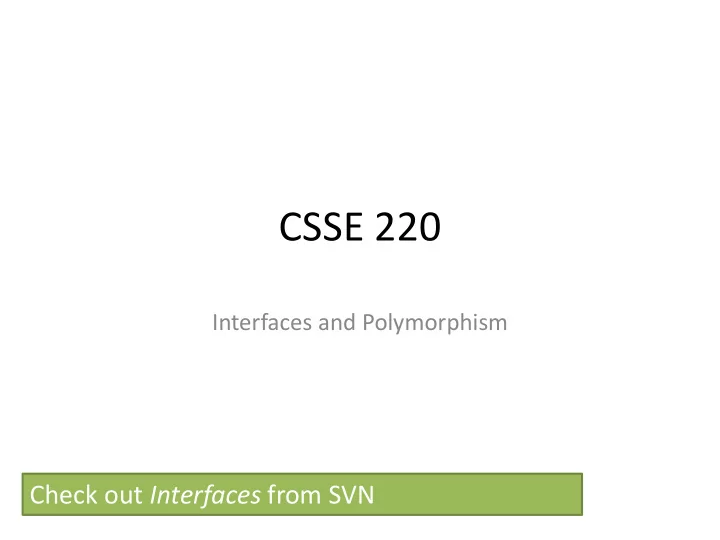

CSSE 220 Interfaces and Polymorphism Check out Interfaces from SVN
Object-Oriented Programming • The three pillars of Object-Oriented Programming – Encapsulation (already covered) – Inheritance (we will partly cover it today) – Polymorphism (also covered today)
Interfaces – What, When, Why, How? • What: – Code Structure used to express operations that multiple class have in common – No method implementations – No fields • When: – When abstracting an idea that has multiple, different implementations
Interfaces – What, When, Why, How? • Why: – Provide method signatures and documentation – Create a contract that someone must follow • Client Code Reuse, for example, Java Event Handlers • How: public interface InterfaceName { //method definitions //We’ll look more closely at the syntax in a later slide }
Interface Types: Key Idea • Interface types are like contracts • A class can promise to implement an interface – MUST implement every method – Client code knows that the class will have those methods • Compiler verifies this – Any client code designed to use the interface type can automatically use the class! • Interfaces help to reduce coupling by tying your design to the interface and not the class implementation. – A new interface implementation can be switched out for the original without changing the rest of the code Q1
Interface Types can be used anywhere that a class type is used. • Once an interface is defined, it can be used as a type. • Say we have an interface named Pet, and Dog and Cat implement this interface… 1. Variable Declaration: • Pet d = new Dog(); • Pet c = new Cat(); 2. Parameters: • public static void feedPet (Pet p) {…} • Can call with any object of type Pet: – feedPet(new Dog()); – feedPet(new Cat());
Interface Types can be used anywhere that a class type is used. ( … continued from last slide) 3. Fields: • private Pet pet; 4. Generic Type Parameters: • ArrayList<Pet> pets = new ArrayList<Pet>(); • pets.add(new Dog()); • pets.add(new Cat());
Notation: In UML • Closed triangle with a dashed line in UML is an “is - a” relationship • Read this as: InterImpl is-an InterfaceName Q2
Why is this OK? Pet p = new Dog(); p.feed(); p = new Cat(); p.feed(); p = new Pet(); // NO! • Any child type may be stored into a variable of a parent type, but not the other way around. – A Dog is a Pet, and a Cat is a Pet, but a Pet is not required to be a Dog or a Cat. – And how could you construct a Pet? • But how does Java know which method implementation to use? Q3
Polymorphism! (A quick intro) • Origin: – Poly many – Morphism shape • Classes implementing an interface give many differently “shaped” objects for the interface type • Java knows what method implementation to use thanks to: – Late Binding : • choosing the right method based on the actual type of the implicit parameter (variable before the dot) at run time – For the p.feed() example: • Java decides at runtime which implementation to use based on the type of the object instance. • The Dog’s feed method may specify dog food, and the Cat’s may specify cat food. Q4
Notation: In Code public interface InterfaceName{ /** interface, not class * regular javadocs */ void methodName(int x, int y); /** Automatically No method public, so we body, just a * regular javadocs here don’t specify it semi-colon */ int doSomething(Graphics2D g); } public class InterImpl implements InterfaceName { … InterImpl promises to implement all the methods declared } in the InterfaceName interface
Refactoring to an Interface • stringTransforms package – Review the code in the stringTransforms package – Attempt to refactor the given code using an interface by thinking about what operation is performed repeatedly – There is a hint at the bottom if you’re not quite sure where to start, but only use it if you need
How does all this help reuse? • Can pass an instance of a class where an interface type is expected – But only if the class implements the interface • We could add new functions to a NumberSequence’s abilities without changing the runner itself. – Sort of like application “plug - ins” • We can use a new TransformInterface without changing the method that uses the TransformInterface instance • Use interface types for field, method parameter, and return types whenever possible. Like Pet instead of Dog, and List for ArrayList. – List <Pet> pets= new ArrayList<Pet>();
Recommend
More recommend